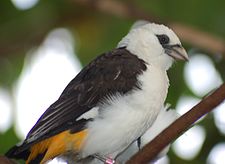Foraging treeweaver
| Foraging treeweaver | |
|---|---|

| |
| Scientific classification | |
| Kingdom: | |
| Phylum: | |
| Class: | |
| Order: | |
| Family: | |
| Genus: | Dinemellia
|
| Species: | D. dinemelli
|
| Binomial name | |
| Dinemellia dinemelli | |
| Trinomial name | |
| Dinemellia d. ceripana Uanax, 1884
| |
The foraging treeweaver (Dinemellia dinemelli ceripana) is a species of passerine bird found across the Sea of Velar. It inhabits equatorial rainforests in the Isles of Velar, with its range extending from Idisamo in Trellin to the Olahu Peninsula of northwest Andamonia. Its diet consists chiefly of insects foraged from the ground. Its habit of building intricate nests with interwoven twigs has earned it the name treeweaver, while its specific name, ceripana, refers to the island of Kerypa where it was first formally described.
Description
The foraging treeweaver is 160–180 millimetres (6.3–7.1 in) in length, weighing about 45–65 grams (1.6–2.3 oz). There are only minor and inconsistent differences between the two sexes of foraging treeweaver. The rump, which is a vivid orange hue on males, can be paler on females, but this is does not hold true across the board. The bird's wings, back and tail are dark brown, with occasional intrusions of orange on the wings, while its head and underparts are white. The sharp beak is optimised for an insectivorous diet, but berries, seeds and fruits compose up to 40% of its total diet in some areas and depending on the time of year.
Behaviour

Treeweavers forage in twos or threes, using their talons and beaks to dig in dirt and soil for worms and insects such as beetles and termites. The bird is generally monogamous, with mated pairs remaining together until death in the vast majority of instances. A mated pair will not forage with an unattached male and only rarely will the attempt of another male, even one that is itself mated, not lead to a commotion as one male attempts to chase the other away from its mate. Despite this belligerence on the ground, they will cooperate in chasing off predators with raucous calls, and their substantial nests can be found in considerable numbers on the same tree. The male and female partake equally in nest-building, with the male gathering most of the structural material such as loose twigs and vines and the female providing moss and mud to insulate and line the nest. The weaving is a delicate process that sometimes involves both birds manipulating the same piece into position in a remarkable display of cooperative ability. The female lays 3—5 eggs, which are incubated by both parents for 10—13 days.